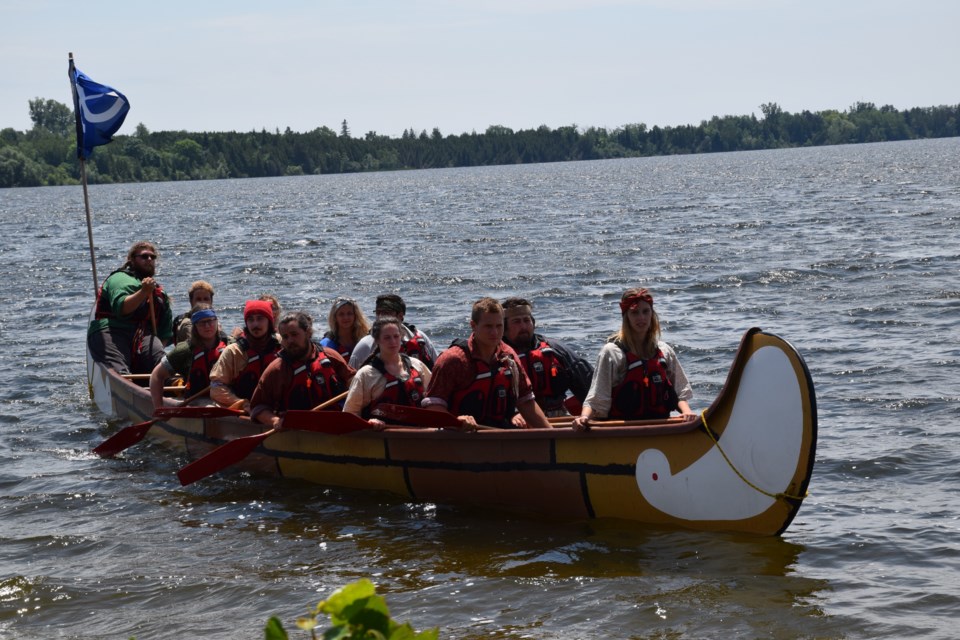Something spectacular was seen on Guelph Lake Thursday afternoon.
A voyageur cargo canoe, paddled by a team of 12 young Métis Nation of Ontario ambassadors, glided over the surface of the water, conjuring up legends of the fur trade and the great birch bark canoes that covered vast distances by lake, river and stream.
This particular canoe was made of more contemporary materials, heavier than the originals, but still very impressive. The paddlers were dressed like the first Métis of centuries ago, a new nation born of unions between Indigenous peoples and European settlers.
From the Ottawa to the Mattawa rivers, across Lake Nipissing to the French River, down the French and over Georgian Bay, along the north shore of Lake Huron and across Lake Superior to the west.
That was the route the 12 paddlers’ ancestors took in the early days of the fur trade, one of the main routes that expanded the trade into the western interior. And that is the route these modern day explorers, men and women alike, are taking across 2,200 kilometres of Ontario.
It is an exploration of ancestry and heritage – a way to see and understand the past from the vantage point of the historic waterway, and through experiencing firsthand the hardship and heroism of those that came before.
About 25 people waited on the shore of Guelph Lake at the Guelph Community Boating Club for the arrival of the paddlers. The visit represented a detour from the historic route, and a rest from the gruelling journey.
The voyage has so far reached Thessalon in northern Ontario, about 90 kilometres east of Sault Ste. Marie and Lake Superior, and about 680 km from the starting point in Ottawa. The destination of the 86-day trek is Kenora, Ont., not far from the Manitoba border and the prairies.
Paddlers trailered the canoe and came south to talk about their experience and the purpose behind the trip, and to promote Métis culture and awareness.
Once they disembarked on the Guelph Lake shore, the paddlers answered questions from those gathered. They wore Métis sashes, knitted garters to keep the bugs out of their pants, beaded medallions, bone chokers, and voyageur hats. Observers could see the pride in their eyes and hear it in their voices.
One spoke of the need on certain days to swing the paddles into action at 4 a.m., just to beat the rising waves expected on big water in big winds. Others spoke of sleeping under the stars and being lulled to sleep by the sounds of nature all around.
“It’s just very soothing to be out there at night,” said Gerald Lavallee.
Christina Smith said she didn’t know much about her Indigenous ancestry, but had been told it originated on Manitoulin Island. The journey took the team close to Manitoulin, and Smith said she felt the spiritual pull of the place.
“It sat good in my stomach,” she said.
Ranging in age from 18 to 25, the explorers were trained in wilderness survival, first aid and swift water paddling before setting out. They cook by fire on the shoreline, sometimes have to squat over a gunwale to relieve themselves, and have to navigate carefully in the event of lightning.
And while black flies have been a huge pest in the north, they have been followed by bald eagles, visited by moose, and had a turtle lay eggs on the beach where they camped one night. The paddlers come from many places, including Hamilton, Barrie, North Bay and the Soo.
Matthew Bombardier said the team was “at the mercy of the water” all day, every day. The trip, he and others said, was an extraordinary way to connect with the ancestors – to feel what they felt, and understand better what they had to do to feed their families.
The average length of a day of paddling is about 40 km, although one day a sail was rigged up in favourable winds and they made 73 km. The craft is 35-feet in length, the same as a historic Montreal canoe.
The route is not what it was back in the 17th and 18th Centuries. Now there are dams on the rivers, and portages across six-lane highways, said Alex Young. One portage was through an entire town.
Jennifer Parkinson is the president of the Grand River Métis Council, Métis Nation of Ontario. She said in an interview that most Métis from her generation grew up not learning about their cultural heritage. That is changing for the younger generation.
The average life span of a voyageur, she said, was 40 years. Métis women were extremely tough. Some went on the canoes, many stayed home for months on end to keep households together.
“The culture had to hide for over 100 years,” she said.
But even now that it is coming out of hiding, Métis do not have the same rights as First Nation and Inuit people, she said. That, too, is in the process of changing.
“We are no longer hiding,” she said. “We can now stand proud next to our Aboriginal and Inuit brothers and sisters on an equal footing.”
